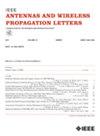一种新型的高增益六角形腔背SIW天线,在Ka波段具有三维均匀透镜加载
IF 4.8
2区 计算机科学
Q2 ENGINEERING, ELECTRICAL & ELECTRONIC
引用次数: 0
摘要
在这篇文章中,提出了一种新型的对称六边形腔背基板集成波导(SIW)三维透镜天线。提出的设计的新颖之处在于从单单元透镜SIW天线获得约20 dBi的增益。所提出的4 × 4多输入多输出(MIMO) SIW透镜在高增益的工作频带内实现了30 dB以上的高隔离。MIMO SIW透镜天线实现1.1 GHz (27.89 GHz ~ 29 GHz)的- 10 dB带宽。它是通过在SIW腔体顶部的一对平行槽来实现的。该设计提供了6.5 dBi的模拟增益,然后通过集成3d打印介质均匀透镜,在28.4 GHz下增强到18.5 dBi。采用腔背透镜天线实现4 × 4 MIMO天线结构。4 × 4 MIMO SIW透镜天线在整个工作频带内(四个天线单元之间)具有超过30 dB的隔离度。实测结果与Ansys HFSS仿真结果吻合较好。稳定的天线性能使其适用于卫星、雷达成像和点对多点无线通信。本文章由计算机程序翻译,如有差异,请以英文原文为准。
A Novel High-Gain Hexagonal Cavity-Backed MIMO SIW Antenna With 3-D Homogeneous Lens Loading at Ka Band
In this letter, a novel symmetrical hexagonal-shaped cavity-backed substrate integrated waveguide (SIW) antenna with 3-D lens is presented. The novelty of the proposed design is achieving a gain of approximately 20 dBi from single unit cell lens SIW antenna. The proposed 4 × 4 multiple-input–multiple-output (MIMO) SIW lens achieves a high isolation above 30 dB for the operating band with high gain. The proposed MIMO SIW lens antenna achieves a −10 dB bandwidth of 1.1 GHz (27.89 GHz to 29 GHz). It is achieved by a pair of parallel slots on top of the SIW cavity. The proposed design offers a simulated gain of 6.5 dBi, which was then enhanced to 18.5 dBi at 28.4 GHz with the integration of a 3-D-printed dielectric homogeneous lens. The cavity-backed lens antenna is used to realize a 4 × 4 MIMO antenna structure. The 4 × 4 MIMO SIW lens antenna has isolation above 30 dB (between the four antenna elements) throughout the frequency band of operation. The measured results are in good agreement with Ansys HFSS simulations. The stable antenna performance makes it suitable for applications in satellite, radar imaging, and point-to-multipoint wireless communications.
求助全文
通过发布文献求助,成功后即可免费获取论文全文。
去求助
来源期刊
CiteScore
8.00
自引率
9.50%
发文量
529
审稿时长
1.0 months
期刊介绍:
IEEE Antennas and Wireless Propagation Letters (AWP Letters) is devoted to the rapid electronic publication of short manuscripts in the technical areas of Antennas and Wireless Propagation. These are areas of competence for the IEEE Antennas and Propagation Society (AP-S). AWPL aims to be one of the "fastest" journals among IEEE publications. This means that for papers that are eventually accepted, it is intended that an author may expect his or her paper to appear in IEEE Xplore, on average, around two months after submission.

 求助内容:
求助内容: 应助结果提醒方式:
应助结果提醒方式:


